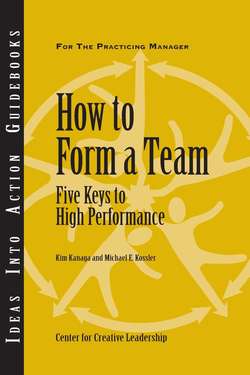Читать книгу How to Form a Team: Five Keys to High Performance - Michael Kossler E. - Страница 8
На сайте Литреса книга снята с продажи.
ОглавлениеWhat Is a Team?
Many kinds of workgroups exhibit cooperative attitudes and practices and might be described as teams. But in this guidebook team refers to a specific kind of group whose members are collectively accountable for achieving the team’s goals. Typically, a team has these five characteristics:
1. Members of the team are dependent upon each other for the completion of a complex task. It’s often advisable to form a team when the task is complex and actually requires the interdependent efforts of a diverse group of people. This typically occurs when the members of a team represent different functional areas of an organization; for example, R&D, engineering, manufacturing, and marketing.
2. Members possess different but complementary skill sets. In many types of workgroups (a company’s sales force, for instance), the members all possess similar perspectives and skills. A defining characteristic of a team is that members bring different sets of skills (and usually different backgrounds and perspectives) to the task. Just as an effective baseball team needs good hitters, good pitchers, and good fielders, a business team needs a combination of abilities to be effective—a combination rarely, if ever, found in a single individual.
3. Teams manage their own work within boundaries set by the organization. Teams are quite autonomous compared to other kinds of groups. A team may be charged with carrying out its work within a specified time period, and may be accountable to a specific individual or management group. But effective teams typically have considerable latitude in how they carry out their work. They decide for themselves how often and for how long they want to meet; which members will take what kinds of responsibilities; and how they will make decisions, handle conflict, and communicate.
4. Teams have internal processes for managing communication, resolving conflicts, solving problems, making decisions, and reaching goals. Teams are not always bound by the same policies and practices by which the organization as a whole works. Deciding on common processes is one of the first tasks of a newly formed team.
5. Teams are bounded and stable over time. Some teams are formed and dissolved in a matter of a few months. Some have a life span of a few years. Others, like the management team of a company, may be a permanent fixture of the organization. In each case, stability of the membership impacts team performance.
Although teams share these five characteristics, the characteristics themselves don’t guarantee that a team will be effective in meeting its goals. One of the first steps to take toward increasing team effectiveness is to pay attention to how you form your team.
